|
James Waite writes:
Sappi Saiccor’s mill at Umkomaas, on the Indian Ocean cost of KwaZulu Natal, 50km south of Durban, is the world’s largest producer of chemical cellulose (dissolvable wood pulp). The material has many applications ranging from the manufacture of fabrics, cosmetics and pharmaceuticals to detergents, cellophane and high-quality plastics. Saiccor (South African Industrial Cellulose Corporation) began construction of the mill in 1952 and production started in December 1955. The company pioneered the production of chemical cellulose from eucalyptus, a development which transformed the economics of the industry. In 1998 the business was bought by Sappi, originally a South African paper company formed in 1936 and now an international conglomerate. The mill has been enlarged over the years and now has the capacity to manufacture 800,000 tons of chemical cellulose per annum. Nearly all the product is exported.
Most of the eucalyptus comes from plantations owned by the company throughout eastern KwaZulu Natal. Currently about half of it arrives by rail along with coal and, occasionally, limestone. The proportion of the wood arriving by rail must once have been considerably higher. Sappi owns many plantations along the route of the old Umzinto-Ixopo-Donnybrook Junction 2ft (610mm) gauge railway which was closed by the SAR in 1986. Photos from the line’s working days show many timber trains heading towards the coast; now the timber from there is necessarily transported along the main road by large numbers of slow-moving, two-trailer trucks which can’t enhance the quality of life for the many people who live along it. Very probably other railways in the district which are now closed also used to carry timber bound for the mill.
The branch to the mill leaves the electrified Durban-Port Shepstone main line in a north-westerly direction just to the north of Umkomaas station. Midway along it is a marshalling yard which marks the limit of the state railway’s electric operation. Beyond lies rather more than 1km of track alongside the Umkomaas river as far as the mill’s weighbridge, after which there are extensive sidings.
At first the railway was operated by three 0-6-0DM’s built by the Hunslet Engine Co. in Leeds or by Hunslet Taylor, its semi-independent South African offshoot. Happily the company later realised the error of its ways and decided that it should become a steam railway! Its steam locos were all cast-offs from the SAR. First to arrive was a G class 4-8-2T, one of twenty five of these locos built by Dubs & Co for the Natal Government Railways in 1904 as their Dubs B class. It was followed by a series of 8 class 4-8-0’s. When it was withdrawn the last in service, 8B no. 7 (ex-SAR 1155, NBL15796/1903), was given to the Umgeni Steam Railway, in the western outskirts of Durban. By then it had become the last member of its class in commercial service anywhere in the country. It’s now on display, in somewhat forlorn condition, at Kloof station at the eastern end of the Umgeni line.
Since 1987 services have been maintained by ex-SAR 19D class 4-8-2’s. The current locos are no. 1 (ex-SAR 2697, Borsig 14748/1938), no. 2 (ex-SAR 2633, Skoda 928/1938) and no. 3 (ex-SAR 2767, RSH 7280/1947). They were fitted with the brass numberplates originally carried by the diesels. The 19D’s were immensely successful branch line locomotives. Their design can be traced back to the 19 class which first appeared in 1928. Two hundred and thirty five 19D’s were built for the SAR between 1937 and 1950. Some of them were amongst the last steam locomotives in service on the system and several are preserved in working order including no. 2685 which is currently the regular operating locomotive on the Umgeni line. In addition twenty one were built for Rhodesia Railways as their 19th class between 1951 and 1953, six for the CF de Benguela in 1951, two for the Nkana mines in Zambia in 1952 which later ended up on Rhodesia Railways and four for Hwange (Wankie) colliery in Zimbabwe in 1955. Altogether they were the most numerous steam locomotive type anywhere in southern Africa.
Further details of the locos so far as known are set out in the list below. No.1’s boiler is unusual as it comes from one of the first twenty locomotives in the class built by Krupp which were domeless, probably the previous no 1 though the domeless boilers were transferred to other locos during their working lives. The locos were all ordered with the SAR’s standard no 1A boiler which carries a dome. It seems that Krupp decided that a dome was not necessary since there was no regulator in the dome, merely a standpipe. At one time two locomotives would generally be in steam, one for shunting the yard and one for line work on the branch. However in recent years the usual pattern of operation has been for one locomotive to be in steam, rotating on a monthly basis, with one spare and the third being overhauled.
Back in 1991 John Middleton and Huw Williams in their book “Industrial Locomotives of South Africa 1991” were able to write that around 100 steam locomotives were in use in industry with about 50 being active at any one time. Those numbers rapidly declined and for several years now Sappi Saiccor has been the last user of commercial steam in the country. The locomotives are kept in excellent condition and their longevity has been aided by the company’s foresight in buying a large stock of spare parts while they were available, from a complete fourth boiler to much smaller components. Sadly the time has come to call a halt, apparently prompted when no. 1 suffered a cracked cylinder as a result of water penetration. The workshops have the facility to repair this but, with the supply of spare parts more generally now becoming critical, the decision was taken to order a replacement diesel. This is likely to enter service in June 2015.
There’s no doubt that there’s a genuine fondness for the steam locomotives amongst many at the company, both in senior management and amongst the operating staff. Indeed some members of the locomotive crews now are active enthusiasts who are there because of the opportunity to work with steam. Sappi struck me as a very happy place and I hope that this comes through in the photos. There will be much real sadness when the fires are dropped for the last time.
There’s attractive scenery along the branch and quite a variety of photo spots which would make a visit worthwhile even if you haven’t been able to arrange access inside the mill. A public road runs alongside the branch for the whole of its length beyond the marshalling yard. It’s crossed at high level by the N2 South Coast motorway though I’d be wary of stopping there, especially on your own, as the traffic’s heavy and there are possibly issues of personal security as well. The main effluent pipe from the mill runs along the north eastern side of the track for much of the route, i.e., its sunny side during the morning and early afternoon, which can pose a challenge for photography. Perhaps the best spot is “Quarry Bend” a little before the mill where the line swings around to the north and the pipe is buried for a short distance. Trains operate twenty four hours a day, seven days a week with pauses around 6.00am, 2.00pm and 10.00pm for an hour or so for shift changes and servicing the locomotive.
I’m immensely grateful to many people at the mill for making this a memorable day, particularly Henry Anderson for arranging our shed visit and Les Reed, the Central Engineering Workshops Manager, for dropping everything when he met us, obtaining permission for us to stay on in the mill and for spending the rest of the afternoon showing us around. John Middleton and Huw Williams have kindly supplied much of the historical info in these notes including the loco list. A special thank you goes to Hawkin Hansen for his advice on the locomotive’s movements and for helping in very many ways and who, with Anthony
Stanton, took me round to visit some of the district’s preserved sugar locomotives and the remains of the narrow gauge in the district - but that’s another story!
Loco list
| 1 |
0-4-0DM |
HT |
4589/1953 |
Possibly sold to Union Co-operative, Dalton (its HT 4589 worksplate was later put on a newer 150 HP loco at Dalton) |
| 2 |
0-4-0DM |
HT |
4337/1954 |
Possibly sold to Shell-BP at Durban. One of the rare duplicated Hunslet works numbers. The HT locomotive register shows it as HT 4337 but HE 4337 was an NCB underground loco in Scotland. The HE registers show the loco as HT built with number 4628. There are no reported observations of its worksplate, so it's not possible to be be certain what number was carried. |
| 3 |
0-6-0DM |
HE |
5436/1958 |
Sold to Tongaat Sugar, Maidstone mill. Out of use there in 1991. |
| 4 |
4-8-2T |
NBL |
16064/1904 |
ex-SAR G class no 201, 12/1962. Withdrawn before 5/1970 and scrapped 6/1972 |
| 5 - orig. 1 (2nd) |
4-8-0 |
NBL |
15819/1903 |
ex-SAR 8C class no 1178, 7/1968. Scrapped 11/1985 |
| 6 - orig. 4 (2nd) |
4-8-0 |
NBL |
15811/1903 |
ex-SAR 8C class no 1170, 5/1970. Dismantled c.5/1978 for
spares; remains scrapped c/1980-81 |
| 7 |
4-8-0 |
NBL |
15796/1903 |
ex-SAR 8B class no 1155, 3/1972. Donated to RSSA, Natal group and moved to Umgeni Steam Railway in 1988 |
| 4 (3rd) |
4-8-0 |
NR |
6330/1903 |
ex-SAR 8D class 8DW, 1197, 2/1973. Given to SAR for museum in exchange for 19D 2767 below, 8/2/1988 |
| 1 (3rd) |
4-8-2 |
Krupp |
1625/1937 |
ex-Dunn's, Hennenman (OFS), c.1/1986; formerly SAR 19D class no 2513 dismantled c/1989 with boiler retained as a spare; remains scrapped 1989-90 |
| 2 (2nd) |
4-8-2 |
Skoda |
928/1938 |
ex-Dunn's, Witbank, 2/1987; formerly SAR 19D class no 2633. In service 2014 |
| 3 (2nd) |
4-8-2 |
RSH |
7280/1947 |
ex-SAR 19D class no 2767, 9/12/1987; acquired in exchange for gift of no 4 (2nd) above to SAR Museum. In service 2014 |
| 1 (4th) |
4-8-2 |
Borsig |
14748/1938 |
ex-SAR 19D class no 2697,10/12/1987. Withdrawn with cracked cylinder 2013/4, partially dismantled |
Other locos were acquired on loan from time to time.
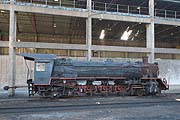 |
No 1 stripped down for spares, note the domeless boiler |
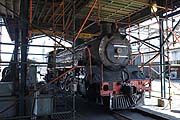 |
No. 2 currently spare engine |
 |
No 3 at the mill, having just brought up a train from the exchange
sidings |
 |
No. 3 being checked over just after shift change |
 |
Left to right, fireman, driver and shunter for the afternoon shift. |
 |
Inside the spacious cab of no. 3, |
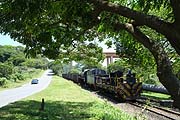 |
A train of empties heads down, note the compressor wagon. |
 |
No.3 'under the wires' at the exchange sidings |
 |
No. 3 at Quarry Bend |
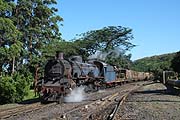 |
No.3 draws the train forward over the weighbridge. |
 |
A high level view looking south-east, no.3 has just come off its
train |
 |
No.3 about to shunt, seen from above |
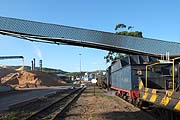 |
No. 3 shunting, note the enormous pile of woodchips |
 |
No. 3 returning from the interchange at sunset |
|
|